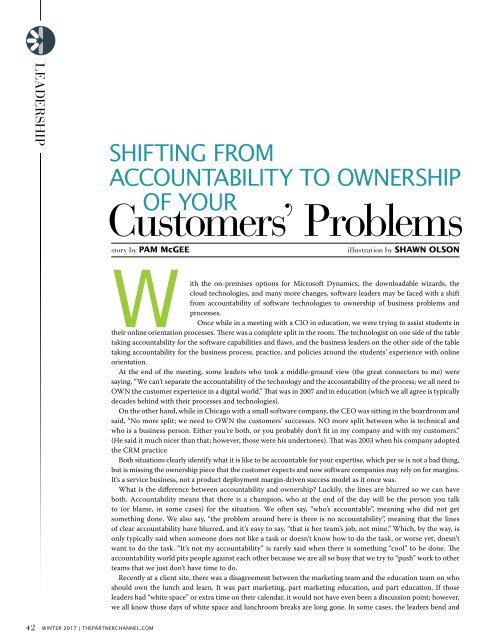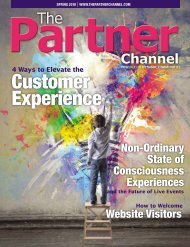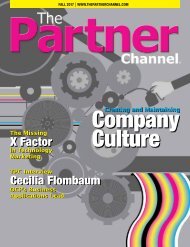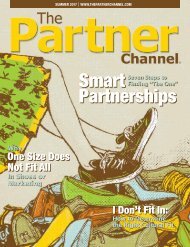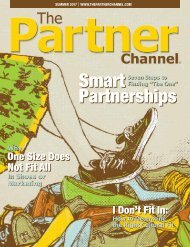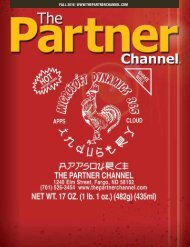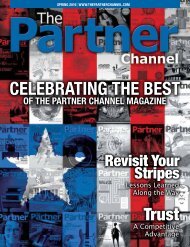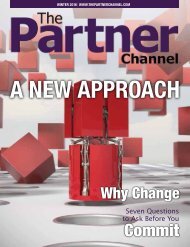The Partner Channel Magazine Winter 2017
The more things change, the more things stay the same. Now that we've had a few months after the Dynamics 365 product launch, this issue takes a look at this concept in a variety of ways; Whether that's how you treat customers or implement tried and true best practices in marketing.
The more things change, the more things stay the same. Now that we've had a few months after the Dynamics 365 product launch, this issue takes a look at this concept in a variety of ways; Whether that's how you treat customers or implement tried and true best practices in marketing.
You also want an ePaper? Increase the reach of your titles
YUMPU automatically turns print PDFs into web optimized ePapers that Google loves.
LEADERSHIP<br />
SHIFTING FROM<br />
ACCOUNTABILITY TO OWNERSHIP<br />
OF YOUR<br />
Customers’ Problems<br />
story by PAM McGEE<br />
illustration by SHAWN OLSON<br />
W<br />
ith the on-premises options for Microsoft Dynamics, the downloadable wizards, the<br />
cloud technologies, and many more changes, software leaders may be faced with a shift<br />
from accountability of software technologies to ownership of business problems and<br />
processes.<br />
Once while in a meeting with a CIO in education, we were trying to assist students in<br />
their online orientation processes. <strong>The</strong>re was a complete split in the room. <strong>The</strong> technologist on one side of the table<br />
taking accountability for the software capabilities and flaws, and the business leaders on the other side of the table<br />
taking accountability for the business process, practice, and policies around the students’ experience with online<br />
orientation.<br />
At the end of the meeting, some leaders who took a middle-ground view (the great connectors to me) were<br />
saying, “We can’t separate the accountability of the technology and the accountability of the process; we all need to<br />
OWN the customer experience in a digital world.” That was in 2007 and in education (which we all agree is typically<br />
decades behind with their processes and technologies).<br />
On the other hand, while in Chicago with a small software company, the CEO was sitting in the boardroom and<br />
said, “No more split; we need to OWN the customers’ successes. NO more split between who is technical and<br />
who is a business person. Either you’re both, or you probably don’t fit in my company and with my customers.”<br />
(He said it much nicer than that; however, those were his undertones). That was 2003 when his company adopted<br />
the CRM practice.<br />
Both situations clearly identify what it is like to be accountable for your expertise, which per se is not a bad thing,<br />
but is missing the ownership piece that the customer expects and now software companies may rely on for margins.<br />
It’s a service business, not a product deployment margin-driven success model as it once was.<br />
What is the difference between accountability and ownership? Luckily, the lines are blurred so we can have<br />
both. Accountability means that there is a champion, who at the end of the day will be the person you talk<br />
to (or blame, in some cases) for the situation. We often say, “who’s accountable”, meaning who did not get<br />
something done. We also say, “the problem around here is there is no accountability”, meaning that the lines<br />
of clear accountability have blurred, and it’s easy to say, “that is her team’s job, not mine.” Which, by the way, is<br />
only typically said when someone does not like a task or doesn’t know how to do the task, or worse yet, doesn’t<br />
want to do the task. “It’s not my accountability” is rarely said when there is something “cool” to be done. <strong>The</strong><br />
accountability world pits people against each other because we are all so busy that we try to “push” work to other<br />
teams that we just don’t have time to do.<br />
Recently at a client site, there was a disagreement between the marketing team and the education team on who<br />
should own the lunch and learn. It was part marketing, part marketing education, and part education. If those<br />
leaders had “white space” or extra time on their calendar, it would not have even been a discussion point; however,<br />
we all know those days of white space and lunchroom breaks are long gone. In some cases, the leaders bend and<br />
42 WINTER <strong>2017</strong> | THEPARTNERCHANNEL.COM


